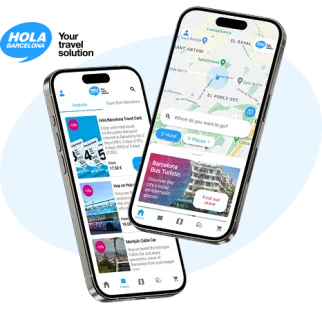Urquinaona - Catalunya - Universitat - Squares and streets
The meeting point of the Old Town and the Eixample
The nerve centre and transport hub of Barcelona is made up of three squares and a series of streets forming a ring that separates the Old Town from the Eixample district. Ronda de Sant Pau, Ronda de Sant Antoni, Ronda de la Universitat and part of Ronda de Sant Pere follow the course of the medieval city walls and form the border of the Old Town.

Barcelona Bus Turístic, on the Hola Barcelona app
Your app for visiting the city with the Barcelona Bus Turístic: routes, stops and the most iconic places. A comfortable way to carry your tickets too!
What is this series of squares and streets?
The series of streets that link Plaça de Catalunya, Plaça de la Universitat and Plaça d’Urquinaona, follows the perimeter of the old city walls in one direction to Avinguda del Paral·lel and in the other to Passeig de Lluís Companys, and separates two very different districts.
Plaça de Catalunya is the most central and largest of Barcelona’s squares and the place where the city’s old town meets the Eixample. Plaça de Catalunya is the origin of some of the city’s main thoroughfares, including La Rambla, Passeig de Gràcia and Rambla de Catalunya, and numerous metro, railway and bus lines run through and under it.
Following the demolition of the city walls in 1858 a decision was made to develop the large area of open space left between the Old Town and what would be the new expansion district or Eixample. Plaça de Catalunya was built in two stages: the first started in 1902 and the second was undertaken for the 1929 International Exposition. The square’s sculptures include "La Deessa" (The Goddess) by Josep Clarà, "El Pastor" (The Shepherd) by Pablo Gargallo, and Josep Maria Subirachs’ monument to the President of the Government of Catalonia, Francesc Macià.
Right next to Plaça de Catalunya, where the Jonqueres gate of the old medieval city wall was located, is Plaça d’Urquinaona, which was named in honour of the Bishop of Barcelona from 1878 to 1883. In the central gardened area you can see the "Font del Noi dels Càntirs", a fountain with a sculpture in the form of a boy carrying water jugs, which was sculpted in 1912 by Josep Campeny i Santamaria. Plaça d’Urquinaona is the confluence of Via Laietana, which runs down to Passeig de Colom and divides the Gothic Quarter and El Born, and Ronda de Sant Pere, which follows the route of the old city wall to Arc de Triomf at the start of Passeig de Lluís Companys.
Ronda de la Universitat starts from the other side of Plaça de Catalunya and runs to Plaça de la Universitat, where the Tallers gate of the old city wall was located. On one side of the square is the neo-Gothic University of Barcelona building designed by Elies Rogent i Amat, while the other side marks the border between the Eixample and Raval districts.
Plaça de la Universitat is also the start of Ronda de Sant Antoni, which is named after an old monastery dedicated to Saint Anthony and is another one of the streets that follow the path of the medieval city walls and separate the Old Town from the new areas, in this case the Sant Antoni district of the Eixample. Ronda de Sant Antoni gives onto Ronda de Sant Pau, which was built over the 1389 city wall and named after a portal dedicated to Saint Paul. Ronda de Sant Pau, which connects to Avinguda del Paral·lel and Poble-sec, divides the Sant Antoni and Raval districts.
How do you get to Plaça de Catalunya?
Plaça de Catalunya is the start and end of both the Blue Route and the Red Route of Barcelona Bus Turístic. Plaça de Catalunya is also the starting point for Catalunya Bus Turístic excursions.
For the most curious of you
- Did you know? Plaça de Catalunya was the financial centre of Barcelona: it used to be home to as many as seven banks. Now only the Bank of Spain remains on the corner with Avinguda del Portal de l’Àngel. The rest are now hotels, boutiques or department stores.
- Local’s tip: Despite being a destination de rigueur for tourists and foreigners, Café Zurich is still used as a meeting place by many Barcelona residents. The café, which has one of the best placed terraces in the city, was opened in 1862 and is one of Barcelona’s oldest.
- A must: To stroll through the city’s nerve centre. It is nigh on impossible to visit Barcelona without setting foot on one of these squares or streets!











